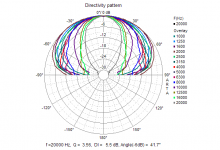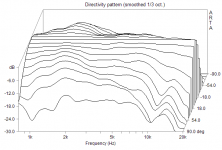Allright, here are results for 4 consecutive measurements of two of Monacor DT-300 aka "Number One" fixed together back-to-back with WG300 waveguides mounted on them. Front speaker has small mod (felt pad removed, cotton filling instead) and much more burn-in hours behind. That may explain some differences between both.
Setup:
1) Connected in-phase parallel;
2) Same with back speaker phase inverted;
3) Same as 2) with back speaker -3dB attenuated with L-pad;
4) "Frontman" only with parallel LR equivalent of back speaker (0.09mH + 7.2 Ohm).
Ungated, 1/3 smoothing, normalized to zero degree, mic distance 0.6m. [Rudolf, according to your will I lifted them up about 5cm on foam pads to give more air ]
]
I hope these will clarify some of threads questions.
Good night, Europe!
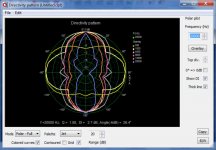
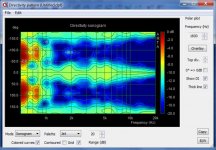
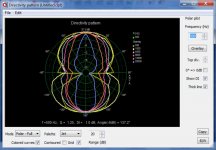
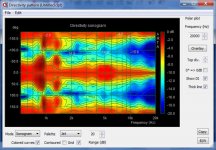
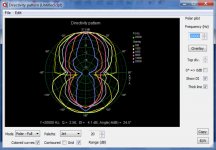
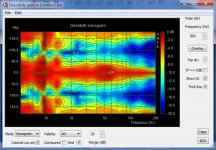
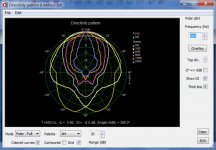
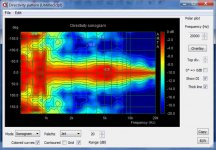
Setup:
1) Connected in-phase parallel;
2) Same with back speaker phase inverted;
3) Same as 2) with back speaker -3dB attenuated with L-pad;
4) "Frontman" only with parallel LR equivalent of back speaker (0.09mH + 7.2 Ohm).
Ungated, 1/3 smoothing, normalized to zero degree, mic distance 0.6m. [Rudolf, according to your will I lifted them up about 5cm on foam pads to give more air
I hope these will clarify some of threads questions.
Good night, Europe!








Last edited:
A dream come true!
Someone has done the job, while I was sleeping!
PRTG, you are such a sport!
This does indeed answer SOME questions:
First I see how badman is perfectly right about the better integration of the inverted polarity wageguides. The "bipole" configuration simply doesn't work as a whole.
Second I see, how starting from 2 kHz (the waveguided area) the radiation pattern up to 60° is almost invariant to the configuration. The waveguide "rules".
Third: The sonograms suggest, that the monopole (front only) pattern may be slighly less disturbed than the front half of the dipole pattern. Can I have the .pir files of the monopole and dipole, please?
Fourth makes me think, if ARTA will ever get the 360° polars right. There is something very suspicious about to many frequency patterns meeting with 0 dB at 0° as well a at 180°.
Cheers
Rudolf
Someone has done the job, while I was sleeping!
PRTG, you are such a sport!

This does indeed answer SOME questions:
First I see how badman is perfectly right about the better integration of the inverted polarity wageguides. The "bipole" configuration simply doesn't work as a whole.
Second I see, how starting from 2 kHz (the waveguided area) the radiation pattern up to 60° is almost invariant to the configuration. The waveguide "rules".
Third: The sonograms suggest, that the monopole (front only) pattern may be slighly less disturbed than the front half of the dipole pattern. Can I have the .pir files of the monopole and dipole, please?

Fourth makes me think, if ARTA will ever get the 360° polars right. There is something very suspicious about to many frequency patterns meeting with 0 dB at 0° as well a at 180°.
Cheers
Rudolf
Hi, Rudolf,
Just sent you all four PIRs (12MB zip). This time I did only 0-180 degrees and made symmetrical.
My conclusions are similar that WG dipole can be very favourable for range under 2kHz in terms of reducing reflections. Benefit of WG dipole in lowering reflections for critical midrange in small rooms seems obvious. If it gives added benefit to soundstage (to be proved with listening) I see strong point in favour of it compared to monopole.
My short first listening impressions is that WG dipole definitely doesn't make much change of sound when walking around loudspeaker.
Ok, must go now. See pictures of changed measurement height with added view from "birds eye".
I'm now going to build "the Arc" to connect baffles with large half toroid and measure again. At this point nice to have feature in ARTA could be 3D measurements (f.e. multiple stacked circulars at height from 1m to 1.8m).
And then next challenge will be most difficult - alignment with 12" bipoles. The fact that fronts will be in phase but rears out of phase will definitely give some weird results and will probably lead to necessity to turn phase of rear bass unit above 300 Hz, for example by adding additional 2-nd order low-pass to rear unit only. Honestly after hard but successful juggling with single front driver alignment I'm a bit afraid hate to ruin what I've done so far. We'll see.
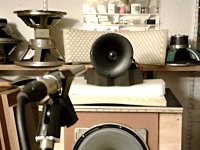
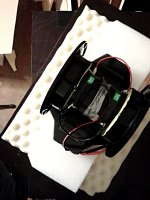
Just sent you all four PIRs (12MB zip). This time I did only 0-180 degrees and made symmetrical.
My conclusions are similar that WG dipole can be very favourable for range under 2kHz in terms of reducing reflections. Benefit of WG dipole in lowering reflections for critical midrange in small rooms seems obvious. If it gives added benefit to soundstage (to be proved with listening) I see strong point in favour of it compared to monopole.
My short first listening impressions is that WG dipole definitely doesn't make much change of sound when walking around loudspeaker.
Ok, must go now. See pictures of changed measurement height with added view from "birds eye".
I'm now going to build "the Arc" to connect baffles with large half toroid and measure again. At this point nice to have feature in ARTA could be 3D measurements (f.e. multiple stacked circulars at height from 1m to 1.8m).
And then next challenge will be most difficult - alignment with 12" bipoles. The fact that fronts will be in phase but rears out of phase will definitely give some weird results and will probably lead to necessity to turn phase of rear bass unit above 300 Hz, for example by adding additional 2-nd order low-pass to rear unit only. Honestly after hard but successful juggling with single front driver alignment I'm a bit afraid hate to ruin what I've done so far. We'll see.


My short first listening impressions is that WG dipole definitely doesn't make much change of sound when walking around loudspeaker.
By this I meant that sound doesn't changes much when walking around loudspeaker. Double WG inverted setup compared to front-only WG fills the room much more nicely. It keeps being more pronounced and articulated and keeps those qualities even after walking into second room. And that's when listening to only one speaker. The difference is so clear and pleasant that I'm definitely not going back to one HF speaker setup.
I also tried -3db attenuation. I found that it somehow "lifts" the sound more into air so that it seems less connected with the speaker and makes it less harsh (latter could be attributed to less pronounced 2-3kHz "plato").
I compared setups 2 (dipole) and 4 (monopole), looking for differences at a higher resolution than provided by polars and sonograms. I started with the frequency response gated at 2.5 ms – practically free from resonances:
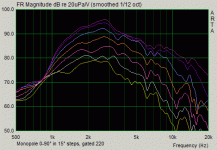
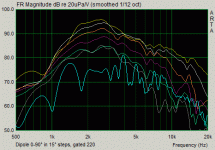
There are small ripples in the response – perhaps due to the non-terminated WGs, as badman suggested. But there is almost no difference between the monopole and dipole diagram up to 60°.
When gating is opened to 4.2 ms, some more detail becomes visible at lower frequencies:
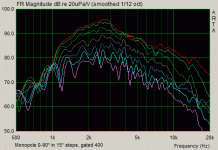
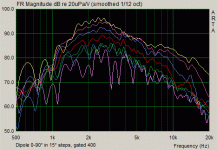
There is a small notch at 1.2 (?) kHz and some added ripple in the 0° response of the dipole diagram (which does show at the 180° end too). Apart from that we see still the same lines as in the monopole diagram. Forget about my “detour” in post # 210 http://www.diyaudio.com/forums/multi-way/161299-directivity-dipole-tweeters-21.html#post2951859 . There is nothing compromising the waveguide function above 1.5 kHz.
. There is nothing compromising the waveguide function above 1.5 kHz.
Rudolf


There are small ripples in the response – perhaps due to the non-terminated WGs, as badman suggested. But there is almost no difference between the monopole and dipole diagram up to 60°.
When gating is opened to 4.2 ms, some more detail becomes visible at lower frequencies:


There is a small notch at 1.2 (?) kHz and some added ripple in the 0° response of the dipole diagram (which does show at the 180° end too). Apart from that we see still the same lines as in the monopole diagram. Forget about my “detour” in post # 210 http://www.diyaudio.com/forums/multi-way/161299-directivity-dipole-tweeters-21.html#post2951859
Rudolf
Great analysis, Rudolf! I also noticed that minor ripple on top of dipole response and added notch at 1kHz and left without the strong clue of the reasons. Still I was surprised how marginal are these differences, I was expecting a bit more of influence between speakers to each other. Still seems that only that is under strong influence is the listener 
Has anyone tried those GRT195 Gradients?
Doesn't really fit my 2-way-for-everything goal, still they have implausible sensitivity for ribbons and decent price. How about trying them for dual waveguide dipole?
Has anyone tried those GRT195 Gradients?
Doesn't really fit my 2-way-for-everything goal, still they have implausible sensitivity for ribbons and decent price. How about trying them for dual waveguide dipole?
I have only seen some measurements of the Mk2 version. They are more horns than waveguides - that is, constantly increasing directivity with frequency. Makes them useable back-to-back too, but you want them directed to your listening position. Their sound WILL change more when walking around them!
Are you really trying to combine the waveguide duo with bipole drivers below? I don't see how that could work properly. Adjusting on-axis phase has a nasty habit to make things worse at 90° in many cases ...
Good luck
Rudolf
Are you really trying to combine the waveguide duo with bipole drivers below? I don't see how that could work properly. Adjusting on-axis phase has a nasty habit to make things worse at 90° in many cases ...
Can you explain a bit more about this nastiness?
Agree, that's ain't easy task, but aiming high is.. nice. Even if I should fail, at least I would have tried.
For my subjective listening experience phase problems are more pronounced than frequency output linearity. That's why designing and tuning passive filters is such a hassle. I see two tasks here:
a) physical phase alignment - aligning voice coils vertically;
b) electrical phase alignment - adjusting passive filters so that usually shifted HF and MF electrical phase "meet each other" as one line around crossover frequency and do it almost flat way - not like crossing of two steep slopes, rather as two closely parallel lines. To reach this objective some phase curve study when selecting speakers.
In some configuration phase curves of speakers may fit from the very beginning including incorrect delay introduced by voice coil misalignment, but that should be rare luck plus harder work with filter tuning
Correctly aligned phase on huge extent can impact also combined output level of drivers around crossover frequency. By shifting phase by 90° of bass drivers (adding second order to LP filter) I filled the problematic dip around 1kHz caused by natural falloff of both drivers combined with phase shift by ~6dB. So making roll-off more steep I actually increased output where even deeper dip was expected.
Ok, this is a bit offtopic, but I'd like to hear other opinions as well.
Last night I added "wings of joy" - two cut-off pieces from aluminium tube filled with construction foam.
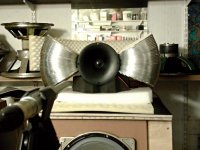
Their shape is round and about 20cm in diameter so it extends the frontal waveguide edge, makes U-turn and goes back to meet the outer edge of rear speaker waveguide. Measurements of this setup should give a clear hint what we could gain (or loose) by implementing full or fractional toroidal baffle for dipoles (waveguided or "naked"). For better comparison I re-took the measurements for original "unwinged" setup with waveguides only.
What I can read from normalized sonograms is less pronounced flares around 1.5kHz and 5kHz. Also seems that somehow maximum level is now narrowly concentrated around 1kHz.
This didn't seem to explain enough so I also looked at not-normalized response. Here we can see that energy dispersion gets wider and more pronounced towards lower (500Hz) and central (1kHz) midrange frequencies, but also zone up to 7kHz gets more energy in dispersed way.
I wanted to also mention ARTA measurement scripting tool. With it directivity measurement becomes very fast and straightforward process. Measure, turn plate, step back, measure, go and turn plate, and so on. I found 8s interval fast and convenient, therefore 12 measurements can be done in less then two minutes.
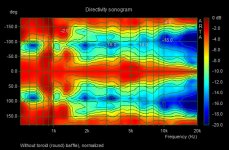
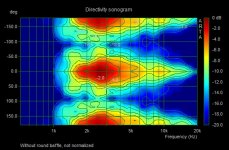
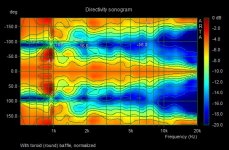
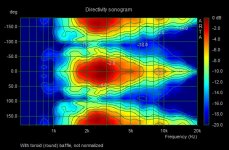

Their shape is round and about 20cm in diameter so it extends the frontal waveguide edge, makes U-turn and goes back to meet the outer edge of rear speaker waveguide. Measurements of this setup should give a clear hint what we could gain (or loose) by implementing full or fractional toroidal baffle for dipoles (waveguided or "naked"). For better comparison I re-took the measurements for original "unwinged" setup with waveguides only.
What I can read from normalized sonograms is less pronounced flares around 1.5kHz and 5kHz. Also seems that somehow maximum level is now narrowly concentrated around 1kHz.
This didn't seem to explain enough so I also looked at not-normalized response. Here we can see that energy dispersion gets wider and more pronounced towards lower (500Hz) and central (1kHz) midrange frequencies, but also zone up to 7kHz gets more energy in dispersed way.
I wanted to also mention ARTA measurement scripting tool. With it directivity measurement becomes very fast and straightforward process. Measure, turn plate, step back, measure, go and turn plate, and so on. I found 8s interval fast and convenient, therefore 12 measurements can be done in less then two minutes.




I've used Monacor WG300 + XT25 with desirable results for quite sometimes now. It is a best compromise between size, cost, and construction so far.
Gainphile, what sensitivity you got with these? What about overall frequency response? Is it similar to this one?
PRTG sent me his ARTA measurement files for his "winged" dipole waveguides:
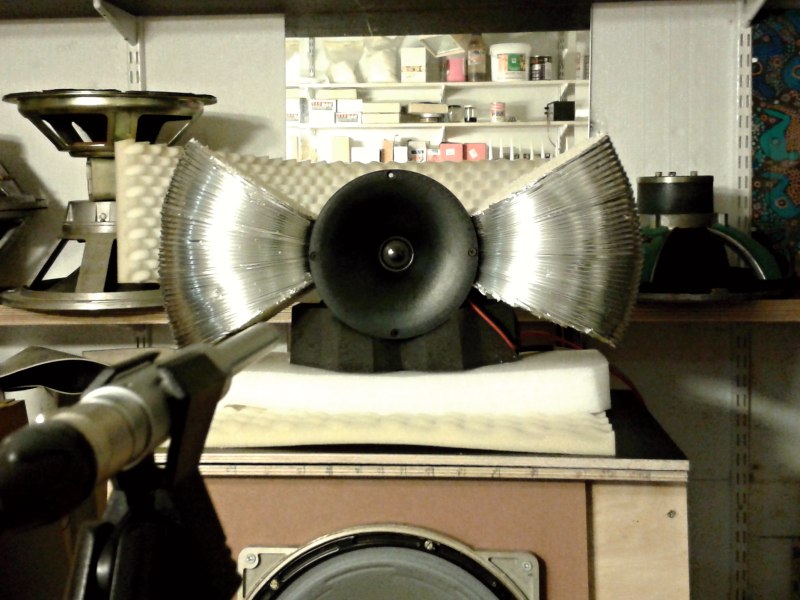
For starters I include the dipole response from the "naked" waveguide dipole in post 23:
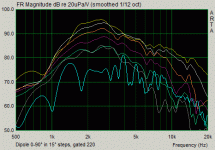
Compare that to the "winged" version 0°-90°:
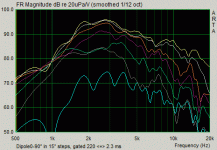
All diagrams have the same 2.3 ms gating. It appears that the "winged" version may have a better/lower noise floor around 90°. But maybe it was just less noise in the room ...
Apart from that we see almost the same irregularities as in the "naked version". Perhaps the aluminium tube needs to be 360° around - and having a smoother transition to the waveguides?
The situation isn't much different for the rear waveguide 90°-180°:
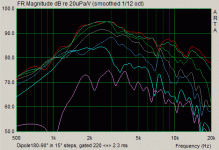
The last diagram just wants to give you an idea how much the measurements to the front match (or don't) with the rear measurements:
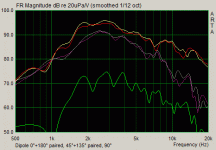
I get the impression that the "full torus" waveguide must be much more elaborate to draw clear conclusions.
But as always: Thanks to Jânis for doing the experiment and supplying the data.
Rudolf

For starters I include the dipole response from the "naked" waveguide dipole in post 23:

Compare that to the "winged" version 0°-90°:

All diagrams have the same 2.3 ms gating. It appears that the "winged" version may have a better/lower noise floor around 90°. But maybe it was just less noise in the room ...
Apart from that we see almost the same irregularities as in the "naked version". Perhaps the aluminium tube needs to be 360° around - and having a smoother transition to the waveguides?
The situation isn't much different for the rear waveguide 90°-180°:

The last diagram just wants to give you an idea how much the measurements to the front match (or don't) with the rear measurements:

I get the impression that the "full torus" waveguide must be much more elaborate to draw clear conclusions.
But as always: Thanks to Jânis for doing the experiment and supplying the data.

Rudolf
Rudolf, great analysis, thanks!
Sure, toroid could be much more elaborate, and stiffer (I thought of stone initially ). What I expected was more smoothness around 5-8kHz (less sharp WG edge termination) and more smooth dispersion around 1kHz. I think we can see both here. The latest is important if we want our tweeter to go so low. I guess for midrange driver in dipole curved baffle edge (R>5cm) would do something similar.
). What I expected was more smoothness around 5-8kHz (less sharp WG edge termination) and more smooth dispersion around 1kHz. I think we can see both here. The latest is important if we want our tweeter to go so low. I guess for midrange driver in dipole curved baffle edge (R>5cm) would do something similar.
Just to remind - we are comparing WG dipole (not naked) against WG + wings (toroid) here.
I was going to do also "true naked" measurement so if you're interested I'll post results here.
Sure, toroid could be much more elaborate, and stiffer (I thought of stone initially
Just to remind - we are comparing WG dipole (not naked) against WG + wings (toroid) here.
I was going to do also "true naked" measurement so if you're interested I'll post results here.
Gainphile, what sensitivity you got with these? What about overall frequency response? Is it similar to this one?
The system is active, so I had not really thought of sensitivity. But I have to reduce the level 5 db compared to mids. So perhaps about 93db?
Gentlemen (and ladies!), I'd like to summarize results of our rough measurements.
1. double-waveguided (double-WG) dipole (two HF speakers fixed back-2-back with waveguides in front) generally copies response of single WG-ed speaker in symmetrical manner at frequencies where wavelength is shorter WG radius (4kHz and above for 16cm diameter WG);
2. at frequencies where wavelength exceeds WG radius (below 4kHz for 16cm diameter WG)
a) gives desired side cancellation aka figure 8 dispersion pattern, but only if phase of one tweeter is inverted in respect to the other;
b) dispersion gradually transforms to transverse (sides only) radiation if speakers are connected in-phase (avoid this);
c) inverted configuration benefits if rear tweeter is attenuated (2-3dB) in respect to the frontal - sound gets slightly more forward character that is perceived as more correct (more optimal direct/reverberant sound ratio).
3. smoothing of WG termination edge connecting front and rear WG with round baffle (toroid for round WGs) gives us
3.1 slight improvement on frequency response smothness ar F where wavelength equals WG radius;
3.2 less pronounced directivity "flare" effect at the same F (may depend on surface transition smoothness - additional evaluation needed);
3.3 extends lower midrange output and dispersion for frequencies that are equal to baffle extension length to second speaker center. Some complex sum/cancellation/drivers resonance smearing pattern probably apply here, still intensity in lower flare region is reduced and smeared compared to single WG speaker;
3.4 besides smoothing overall round baffle eats up some direct radiation energy (may be material stiffness dependent - additional evaluation needed).
Subjectively double-WG dipole doesn't sound any worse than 1., quite contrary, it gives even less attachment to speaker aka more airy appearance.
Testing was done in small room without special treatment except some foam pads on closest surfaces.
For real world applications 1.-3. may give favorable effects for all dipole hi-mid/tweeter applications. 3. may give very pronounced improvement for tweeters that need to be crossed low (under 3kHz), and effect would be proportional to overall baffle size. Still the bigger it is the harder it gets to construct. Some may also find toroidal baffle appearance a bit weird unless done from solid wood with perfect piano lacquer finish (think about B&W Nautilus symmetrical). I find the sound of symmetrical drivers with waveguides sounding superior than single waveguided put on flat baffle or mounted alone, and far superior than single driver on baffle or alone. Half-toroid baffle was not completed on its full so the effects were only pronounced on horizontal plane.
Planned further improvements:
- tests with larger diameter/depth WG to better interfere with 12" drivers;
- more elaborate construction and testing with toroid and WG300 waveguides;
- adding small 3" mid drivers in sides of toroid to get more punch on mids (think of shallow unity horn).
Comments are welcome.
1. double-waveguided (double-WG) dipole (two HF speakers fixed back-2-back with waveguides in front) generally copies response of single WG-ed speaker in symmetrical manner at frequencies where wavelength is shorter WG radius (4kHz and above for 16cm diameter WG);
2. at frequencies where wavelength exceeds WG radius (below 4kHz for 16cm diameter WG)
a) gives desired side cancellation aka figure 8 dispersion pattern, but only if phase of one tweeter is inverted in respect to the other;
b) dispersion gradually transforms to transverse (sides only) radiation if speakers are connected in-phase (avoid this);
c) inverted configuration benefits if rear tweeter is attenuated (2-3dB) in respect to the frontal - sound gets slightly more forward character that is perceived as more correct (more optimal direct/reverberant sound ratio).
3. smoothing of WG termination edge connecting front and rear WG with round baffle (toroid for round WGs) gives us
3.1 slight improvement on frequency response smothness ar F where wavelength equals WG radius;
3.2 less pronounced directivity "flare" effect at the same F (may depend on surface transition smoothness - additional evaluation needed);
3.3 extends lower midrange output and dispersion for frequencies that are equal to baffle extension length to second speaker center. Some complex sum/cancellation/drivers resonance smearing pattern probably apply here, still intensity in lower flare region is reduced and smeared compared to single WG speaker;
3.4 besides smoothing overall round baffle eats up some direct radiation energy (may be material stiffness dependent - additional evaluation needed).
Subjectively double-WG dipole doesn't sound any worse than 1., quite contrary, it gives even less attachment to speaker aka more airy appearance.
Testing was done in small room without special treatment except some foam pads on closest surfaces.
For real world applications 1.-3. may give favorable effects for all dipole hi-mid/tweeter applications. 3. may give very pronounced improvement for tweeters that need to be crossed low (under 3kHz), and effect would be proportional to overall baffle size. Still the bigger it is the harder it gets to construct. Some may also find toroidal baffle appearance a bit weird unless done from solid wood with perfect piano lacquer finish (think about B&W Nautilus symmetrical). I find the sound of symmetrical drivers with waveguides sounding superior than single waveguided put on flat baffle or mounted alone, and far superior than single driver on baffle or alone. Half-toroid baffle was not completed on its full so the effects were only pronounced on horizontal plane.
Planned further improvements:
- tests with larger diameter/depth WG to better interfere with 12" drivers;
- more elaborate construction and testing with toroid and WG300 waveguides;
- adding small 3" mid drivers in sides of toroid to get more punch on mids (think of shallow unity horn).
Comments are welcome.
Last edited:
The last diagram just wants to give you an idea how much the measurements to the front match (or don't) with the rear measurements:
First I thought that these are due front speaker being slightly modded (Z smoothing felt pad removed to lower resonance). Then while tinkering with Monacors to reduce Fo from 1.6kHz to at least 750Hz (specs value) I accidentally found the root cause of these differences. Seems that DT-300s may contain a flaw right from the factory and the chance to "get" it is about 50/50. Or we may say that it can be assembled for 2 different behaviours.
Let me explain in detail: when faceplate along with membrane and coil is removed there are two possible positions how to mount it back - as is - or rotated by 180 degrees. In reversed position impendance is nearly flat (nice!) but sensitivity in 1-4kHz region is reduced by 6-8dB (too bad!) and by ~3dB at the top end. Perhaps voicecoil is pressed against one of sides of flux gap but without apparrent distortion as there is lots of magnetic oil involved. So seems that this is "flawed" position and assembly line randomly picks up one position or another. There is a second benefit though - this assembly position gives nearly flat response with WG-300 waveguide - no electrical correction is needed
To be sure that it's not coincidence I took Z-response diagrams of two other freshly unpacked DT-300 items:
View attachment 281297
Unbelievable. If turning faceplates also of these two fresh speakers will swap their Z response I'm going to inform Monacor that they may have some serious assembly precision or CAD/CAM design problems for this driver. Lets hope they already have it corrected and I just had a flawed batch.
Hi Rudolf,
excellent work on dipole tweeters
Did you also experiment with the two tweeters wired in phase thus making a bipole tweeter. Compared to dipole phasing, believe a bipolar phasing would have the benefit of :
1)no dipole cancellation and hence lower cutoff
2)wider dispersion due to wrap around from the opposite tweeter, providing near omnipolar radiation before beaming starts.
However, constant directivity will likely be poorer than a dipole phasing.
Any thoughts ?!
excellent work on dipole tweeters
Did you also experiment with the two tweeters wired in phase thus making a bipole tweeter. Compared to dipole phasing, believe a bipolar phasing would have the benefit of :
1)no dipole cancellation and hence lower cutoff
2)wider dispersion due to wrap around from the opposite tweeter, providing near omnipolar radiation before beaming starts.
However, constant directivity will likely be poorer than a dipole phasing.
Any thoughts ?!
- Home
- Loudspeakers
- Multi-Way
- On the directivity of dipole tweeters
